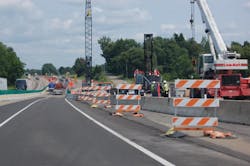One of the sessions this week at the 95th annual meeting of the Transportation Research Board (TRB) dealt with what’s often become a rather thorny issue where trucking in concerned: the growing link between public health concerns and transportation planning.
The session is question ostensibly provided a forum to discuss “what’s hot” among state department of transportation (DOT) agencies across the country.Yet it touched on that latest of trucking bugaboos, greenhouse gas (GHG) emissions, and how state DOTs are trying to reduce them as they work on various transportation projects.
Michael Trepanier, senior environmental planner with the Massachusetts DOT (MassDOT), laid the issues out very clearly.
“There is a big push for this,” he explained. “There is a hugely increased desire for DOT officials to consider human health in the transportation decision making process because there are significant impacts, positive and negative, transportation choices can have on human health.”
Trepanier talked about the “huge long list of negative health effects” vehicle emissions in particular can create for humans: cardiopulmonary issues, lung-related issues, and higher rates of obesity.
“There are associations between travel behavior and public health,” he stressed. “The research not strong enough yet for a direct ‘pathway’ linking the two, but there is enough strong associative evidence between how a transportation system moves people and how it affects them and their behavior.”
Some of the “associative conditions” he referenced concerned air pollution, lack of physical activity, excessive noise, safety, and travel comfort.
This is also part of what Trepanier dubbed the “new urbanism” taking root in American cities: the desire to de-elevate roadways and overpasses, while offering more connected, mobile, accessible open spaces, separated bike lanes, and increased access to mass transit.
“Using health pathways will determine health outcomes [and] help us predict an up or down change in health based on transportation choices,” he explained.
Developing more bike pathways, for example, is viewed as an opportunity to generate more physical activity, which should then – by extension – foster a change in disease rates.
“We need to identify better guidelines at the national level for this,” Trepanier added. “But we expect to continue such inter-disciplinary cooperation between health and transportation. That will ensure we gain the public health outcomes we expect to have.”
How does all of that affect trucking?Well, if you think more roads would help alleviate freight congestion and delays, you might find that idea a non-starter when “associative affects” are factored in.
“Anytime we have more pavement, that becomes a tougher sell – especially for widening [transportation] corridors, whether for [mass] transit, rail, or roadways,” noted Kevin Walsh, MassDOT’s director of environmental services
Trapanier added that state DOTs thinking along these lines hope to engage “health considerations” earlier into their transportation project process, so such health-focused measures create “a longer, durable impact” for the public as a whole.
Yet he stressed that health outcomes are not taking on a direct decision-making role in planning, but rather will act to “support” the decision-making process.
“We don’t have strong handle on this yet on how health and transportation fit together directly,” Trepanier point out. “We want to see health [concerns] used to support decision-making, not to actually make decisions. How we incorporate all of this is also a little frightening, because don’t want to see more work added to the planning process either.”
It’ll be even tougher, no doubt, if health concerns bog down freight projects. But then again, incorporating a health-focus could open the planning to better freight solutions, too.
We’ll see how that works out.


